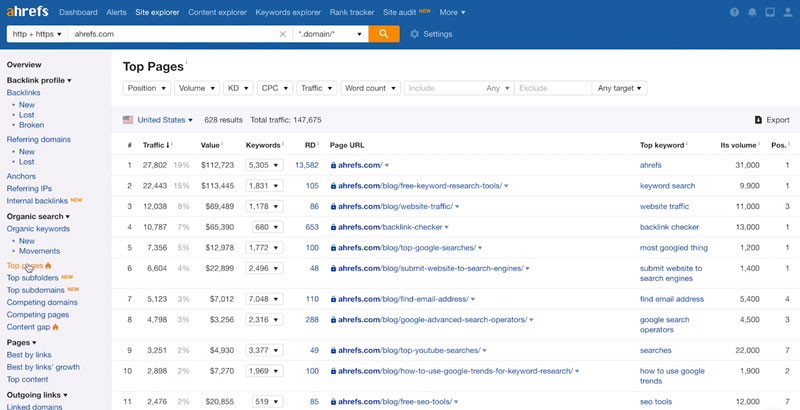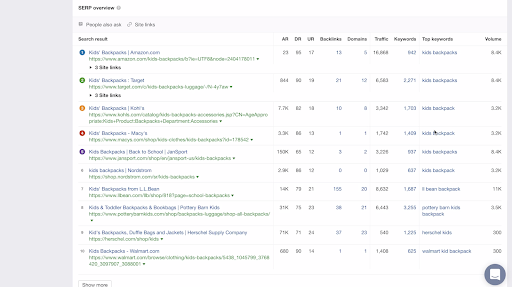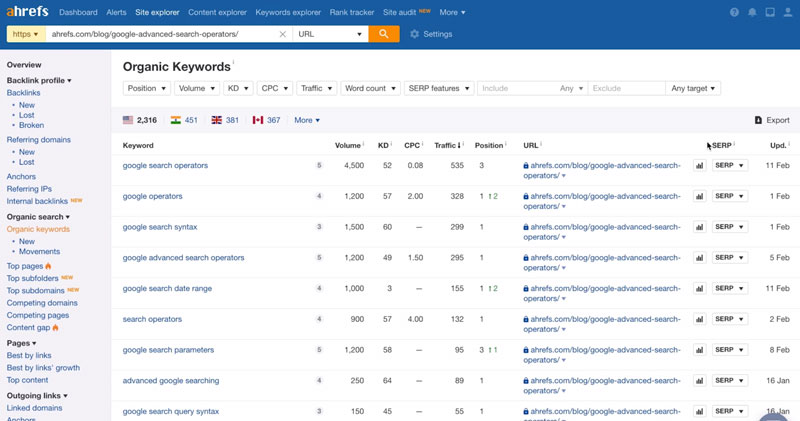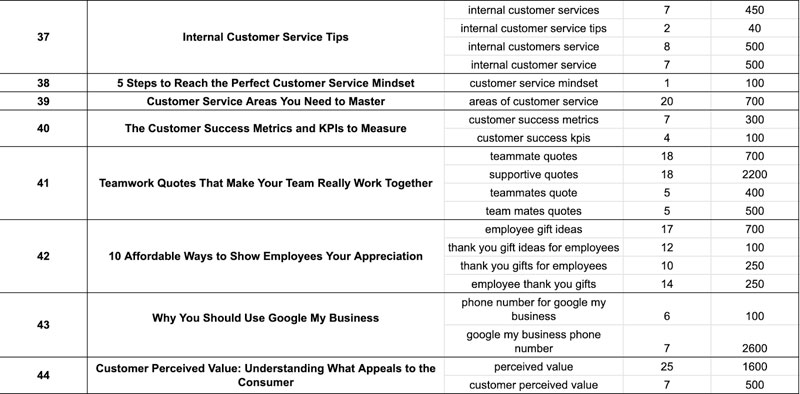How To Create a Content Marketing Database to Best Use Your Time
This page may contain links to Amazon.com or other sites from which I may receive commission on purchases you make after clicking on such links. Read my full Disclosure Policy

The world is full of things to write about, but for content marketing it’s important to cover the topics your target audience is searching for online. I’m pleased to welcome Marketing Specialist Jakub Kliszczak, who’s written a great tutorial to help you find out what those topics are and create a content marketing database for the best results.

Content marketing is the best way to generate traffic and generate new customers…
You’ve probably heard it more than once before. And while I wholeheartedly believe in it, content marketing can easily get messy and take a lot of time just on the organization side.
That’s why, today, I’d like to show you how you can create a content marketing database that will save you hours of research and unproductive time trying to find the perfect topic to write on.
With this simple framework and exact tools, and methods that I’m going to show you, you’ll be able to write an article without having to spend time on endless ‘looking for inspiration’ or searching for references.
Once you’re done with it, you’ll be all set for the next couple of months!
Researching Keywords & Topic Ideas
Firsts things first.
We have to begin with topic ideas and keywords you’re going to write on.
Here, I’d suggest you do it in one of the three ways:
- Research what’s already working for your competition
- Get creative and write down your own ideas
- Start with a broad topic and narrow it down
To make the whole process much easier, faster, and more accurate I’ll show you how to do everything using a software called Ahrefs.
Ahrefs is a paid option (with a 7-day trial) but will give you the most accurate results.
Yet, if you’d like to try something different or you already use a different solution, you can get the same outcomes, no problem with that.
Besides Ahrefs I highly recommend trying out Moz (paid with a 30-day free trial), UberSuggest (limited but 100% free), and Keywords Everywhere.
Piggyback your competition

When it comes to the first method, you can use tools such as Ahrefs to uncover what your competition’s up to.
To do that go to the Content Explorer tab and type in the topic you’d like to write on. Then set filters (Add filter), Referring Domain to ‘From 10′ and check which pieces of content get recognized online.
Save those.

The other way to do that is to insert your competitor’s website to the Site Explorer and go to the Top Pages tab.
There, it will show you which of their articles are ranking the highest. These are your golden nuggets!
Get creative
The second technique is quite straightforward. Turn on your creative thinking and write down anything you’d like to write about.
You’ll be able to, later on, check whether any of these ideas have a chance to rank organically using Keywords Explorer which I describe in the next method.
Start broad, finish narrow

For the last idea, I’d use the Ahrefs Keywords Explorer. There, you can type in any given keyword, let’s say ‘backpacks’ and check the having the same term tab.
There, you’ll think of the so-called long-tail version of your keyword. This way, you’ll narrow down the previously broad topic to very specific terms that people are looking for.
What’s also great about this method is the fact that long-tail keywords are often much easier to rank for than there broad parent topics. Thus, you’ll quickly get to the first page of Google and get more clicks as the term is very specific.
Gathering keywords
Now, through this research, we’ve got a bunch of topic ideas along with single keywords. The next step will be to squeeze as many viable keywords per piece as we can.
That’s because your pieces of content should be topic-relevant and not only focused on one term. To make sure your content is, in fact, topic-relevant include LSI keywords. These keywords indicate that you know the topic in its broader scope.
The easiest example would be a piece around the topic of football. Here, the main keyword would be football but instead of plugging it all over the place it would be neat to also include terms such as referee, ball, Champions League, Messi, Ronaldo, etc.
To find all the keywords you can use that are related to a certain topic we’re going to reverse-engineer what’s already working.

So, now take keywords/topics that you’ve found through your research and put each of them into Ahref’s Keyword Explorer (or you can just search for the keyword on Google, given that you search from the US).
Next, go to the SERP overview and check out the best pieces from the first page of Google.
Copy links to each of these pieces, paste them into Content Explorer and go to the Organic Keywords tab.

There you’ll see all the keywords a certain piece of content is ranking for. Take the ones that have significant volume and that your competitors already rank for.
When you’re done, you’ll have a file full of topic ideas along with ready-to-use keywords!
Storing all the data
Now, that you’re equipped with all the data, we’ll make sure it remains accessible to you at all times.
Depending on your equipment and background you probably prefer different software. Here, I’m going to show you how you can create a simple content marketing database using free-for-everyone Google Sheets.
Yet, you can get the same results using software such as Numbers or Airtable.

Create four different rows. One for topic ideas, second for keywords, and third and fourth for their difficulty score and global volume.
Now, plug the topics you’ve found – here, use the headlines of your competitors or, better, create your own, so you can use them later while writing.
Then insert the keywords with their respective keyword difficulty and volume. These metrics will help you prioritize which piece to create first. After all, if you aim for traffic it will be important to rank as fast as possible.
Lastly, make sure to frame all the cells regarding one topic idea so you’ll have a clear overview of what belongs to where.
I bet you have your way of doing such things and organizing your resources. Thus, feel free to experiment with your database and make it as accessible to you as possible.
The whole premise of doing it is that you can open the file, take a look at it and already have an idea of what to write about.
This way you don’t lose time on research, finding inspiration or checking what’s your competition up to.
Time to make it work
Assuming that you’ve done all the previous steps, you should be good for another couple of months. With such a database, you’ll get an idea of what to create with a quick glance at it.
Now, make sure you don’t stop there.
Content marketing is only useful when executed with quality and consistency.
The best practice would be to put out the content regularly.
Yet, don’t stress yourself too much over the deadlines as it may cause the decline of quality. Make sure you balance both as your pieces have to be optimized for both robots (think topics and keywords) and humans (think language, structure).
Good luck and many top-notch clients!





Lots of great ideas here. A little planning ahead can make the creation part feel less stressful!
Such a difference! A while back I created a spreadsheet with ideas for my blog and newsletter, but after I used up the best ideas, I stopped using it. I recently pulled it out when I was stuck for a topic for my next newsletter and came across a topic that’s definitely worth covering – I hope you will like it!
I’m sure I will!
Great ideas – intimidating but great!
It might be worth it… blogging is already a fair bit of work, so anything we can do to make our efforts more effective is a good idea!
Phew! This is an intense process. Honestly, I’m not sure I’m up to the challenge. But perhaps I’m thinking too small.
You and me both, Linda!
Thanks for sharing this information. It’s information that is not shared that often.
I do find a lot of great keywords for my clients on these sites. These sites are also helpful for PPC advertising on Google. I use them to generate the right mid-level competitive keywords for their PPC ads because you don’t want to use too many popular keywords in PPC advertising. Those competitive keywords will cost a fortune.
There’s definitely a learning curve to using any of these keyword research tools, but I think it’s worth it in the end.
I need to do this to get more effective marketing out of my blog posts. Thanks.
It seems that no matter how much effort we put into blogging, there is always more we can do!
This is intense, but likely the exactly kind of methodical planning we should be doing for modern blogging success. (Sigh. I remember the days of the web before graphics. It was harder to get traffic but easier to feel accomplished with just your words.) This will take an investment of time (and some money) but it’s obviously worth it to have more effective marketing.
I hear you, Julie! I can’t believe I’ve been using the internet for over 20 years – and that there’s not a kid in school today who can imagine a world without it!
Thank you for all of these tips on creating a content marketing database. This is definitely something I need to do! I write content regularly, but I have not done this type of research.
I did quite a bit of research when I started this blog, but that was a very long time ago – I don’t even know if these tools existed then! It’s definitely worth taking a look – as I said in another comment, there’s always room for improvement in our blogs.